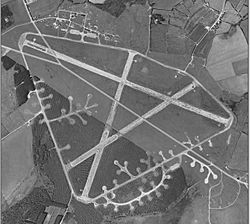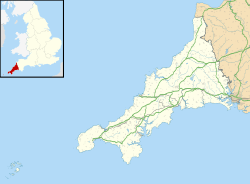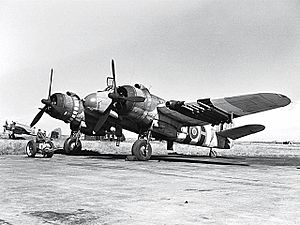RAF Davidstow Moor facts for kids
Quick facts for kids RAF Davidstow Moor
|
|||||||||||
|---|---|---|---|---|---|---|---|---|---|---|---|
| Davidstow, Cornwall in England | |||||||||||

RAF Davidstow Airfield – 2 June 1951
|
|||||||||||
|
Shown within Cornwall
|
|||||||||||
| Coordinates | 50°38′07″N 004°37′04″W / 50.63528°N 4.61778°W | ||||||||||
| Type | Royal Air Force station | ||||||||||
| Site information | |||||||||||
| Owner | Air Ministry | ||||||||||
| Operator | Royal Air Force 1943-44 United States Army Air Forces 1942 |
||||||||||
| Controlled by | RAF Coastal Command * No. 19 Group RAF |
||||||||||
| Site history | |||||||||||
| Built | 1941/42 | ||||||||||
| In use | October 1942 - December 1945 | ||||||||||
| Airfield information | |||||||||||
| Elevation | 295 metres (968 ft) AMSL | ||||||||||
|
|||||||||||
RAF Davidstow Moor was a special place in Cornwall, England. It was once an airfield used by the Royal Air Force (RAF). An airfield is like a big airport for military planes.
This airfield was active during World War II, from late 1942 until 1945. It played a part in protecting the coast of Britain. Even though it was busy at times, it was not one of the most used airfields by RAF Coastal Command.
Contents
History of RAF Davidstow Moor
The land for RAF Davidstow Moor was bought in 1941. Workers quickly built a large airfield with three runways in 1942. Building it on the moorland was fairly easy. They had to remove some fences and close small roads. They also did some work to drain water from the land.
After World War II
RAF Davidstow Moor closed in December 1945 when World War II ended. Many of its buildings, including the aircraft hangars, were taken down. The airfield then found a new purpose. It became a motor racing track called Davidstow Circuit.
In the early 1950s, exciting Formula One races were held there. One of these races was the first win for the famous Team Lotus car company. This was a big moment in racing history!
Squadrons and Their Missions
Many different RAF squadrons used Davidstow Moor during the war. They flew various types of planes for important missions.
| Squadron | Dates stationed | Planes used | Duties |
|---|---|---|---|
| 53 Sqn | January 1943 – February 1943 | Lockheed Hudson | Coastal patrols |
| 144 Sqn | May 1944 – July 1944 | Bristol Beaufighter | Protected the western side of the Normandy landings. Helped fight German naval forces. |
| 206 Sqn | March 1944 – April 1944 | Consolidated Liberator, Boeing Fortress | Long-range patrols |
| 269 Sqn | January 1944 – March 1944 | Lockheed Hudson, Supermarine Walrus | Air-sea rescue missions, saving pilots and sailors. |
| 281 Sqn det | December 1943 – February 1945 | Vickers Warwick | Air-sea rescue duties |
| 282 Sqn | February 1944 – September 1944 | Vickers Warwick | Air-sea rescue duties |
| 304 Sqn | June 1943 – December 1943 | Vickers Wellington | Anti-submarine patrols over the Bay of Biscay. |
| 404 Sqn RCAF | May 1944 – September 1944 | Bristol Beaufighter | Coastal patrols |
| 524 Sqn | April 1944 – July 1944 | Vickers Wellington | Patrolled against German fast attack boats off the French coast. |
| 547 Sqn | May 1943 – October 1943 | Vickers Wellington | Anti-submarine patrols over the Bay of Biscay. |
| 612 Sqn | April 1943 – May 1943 | Vickers Wellington | Anti-submarine patrols over the Channel and the Bay of Biscay. |
| 1603 (AAC) Flt | December 1942 – January 1943 | Hawker Henley | Used for target towing practice. |
Current Use of the Airfield
Today, the old watch office, which was like the control tower, is still visible. The airfield is partly used by small aircraft. These include microlights and motor gliders.
Three runways are still in use for these smaller planes. You need to get permission before flying there. The Davidstow Flying Club runs the site now.
Davidstow Airfield and Cornwall at War Museum
The Davidstow Airfield and Cornwall at War Museum helps us remember the people and work of RAF Davidstow Moor. It is located near a creamery where famous cheeses are made.
The museum has many exhibits about life in World War II in Cornwall. You can learn about other airfields, the Royal Navy, the Army, and how people lived at home. There are also items from the Royal Observer Corps and the Light Infantry. You can see old vehicles and weapons. A new hangar built in 2016 holds bigger exhibits. These include a Fairey Gannet and a Hawker Hunter F.6 aircraft. There is also the cockpit of a DH Vampire T.11 and many rare military vehicles.
Davidstow Moor RAF Memorial Museum
Next to the main museum is the Davidstow Moor RAF Memorial Museum. It is in the old sergeants' shower building. This museum focuses on the airfield's history during World War II. It uses old photographs and special items to tell its story.



